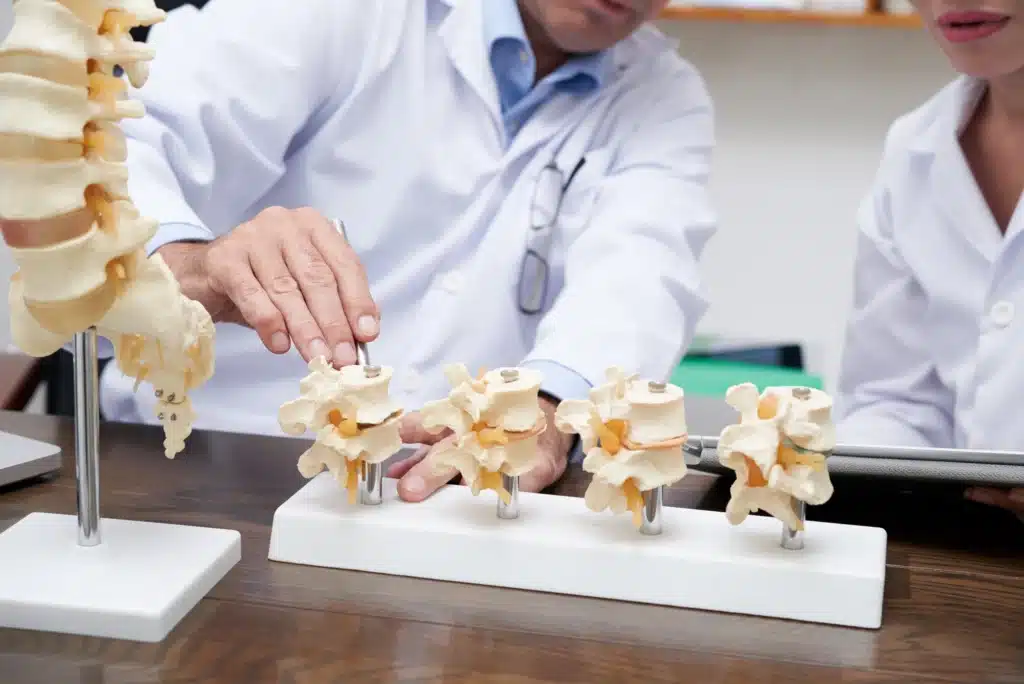
Table of Contents
ToggleHas traditional open spine surgery been recommended, but you’re concerned about the long recovery time and potential risks? There is good news – minimally invasive spine surgery may be a viable option for you.
This advanced surgical technique has revolutionized the way spine surgery is performed, offering faster recovery times, reduced pain, and smaller scars. In this article, we’ll explore the benefits of minimally invasive spine surgery, types of procedures, and what to expect during recovery.
Imagine being able to return to your normal activities and daily routine just a few weeks after spine surgery, instead of months. With minimally invasive spine surgery, that’s now possible.
With this approach, patients experience less pain, reduced scarring, and shorter hospital stays, making the recovery process much more manageable.
Additionally, the reduced risk of complications during and after the procedure means that patients can enjoy peace of mind knowing that their safety is a top priority.
Finally, minimally invasive spine surgery also provides an excellent cosmetic result, as the smaller incisions used during the procedure result in less visible scars.
Overall, if you’re tired of living with chronic back pain and want to fast-track your recovery, minimally invasive spine surgery offers a safer, less painful, and more aesthetically pleasing alternative to traditional open surgery.
Got a nagging spinal problem? Don’t worry, minimally invasive spine surgery (MISS) can help you get rid of the discomfort and get back to your normal routine in no time!
This advanced technique can treat a variety of spinal issues such as herniated discs, spinal stenosis, scoliosis, degenerative disc disease, spinal tumors, and fractures/dislocations.
Herniated discs, spinal stenosis, and scoliosis can be fixed with ease, while MISS can replace damaged discs with artificial ones.
In the case of spinal tumors, MISS can remove them without damaging the surrounding healthy tissue. And for fractures and dislocations, MISS can stabilize the spine, ensuring a swift and speedy recovery.
So, if you’re tired of the pain and long recovery times associated with traditional spine surgeries, minimally invasive spine surgery is the way to go!

There are several types of minimally invasive spine surgeries available, each with its unique approach to addressing different spinal problems.
Here are the most common minimally invasive spine sugery that will help you to fast track your recovery and get back to enjoying life.
Microdiscectomy is one of the most common types of minimally invasive spine surgery. It involves removing a portion of a herniated disc that is compressing a nerve and causing pain.
The surgeon makes a small incision and uses specialized tools to remove the problematic disc material. Microdiscectomy causes less tissue damage than traditional open surgery, resulting in less pain and a quicker recovery time.
Spinal fusion is another minimally invasive spine surgery that is frequently performed. This procedure involves joining two or more vertebrae together to stabilize the spine and reduce pain caused by movement.
During spinal fusion, the surgeon makes a small incision and inserts small instruments and screws to hold the vertebrae in place while they fuse together. The recovery time for spinal fusion varies, but most patients can resume daily activities within a few weeks.
Artificial disc replacement is a type of minimally invasive spine surgery that replaces a damaged or degenerated disc with an artificial one. This procedure is an alternative to spinal fusion and is typically performed on patients with disc degeneration or other disc-related issues.
During the procedure, the surgeon makes a small incision and replaces the damaged disc with an artificial one. Recovery time for this procedure is similar to spinal fusion, and patients can expect to return to normal activities within a few weeks.
Laminectomy is a minimally invasive spine surgery that involves removing the lamina, which is the back part of the vertebra, to relieve pressure on the spinal cord or nerves.
This procedure is commonly used to treat spinal stenosis or other conditions that cause pressure on the spinal cord. During a laminectomy, the surgeon makes a small incision and uses specialized tools to remove the lamina.
The recovery time for this procedure varies depending on the extent of the surgery, but most patients can return to normal activities within a few weeks.

First off, the good news is that the recovery time for this type of surgery is usually shorter than traditional open surgery. The reason being that the incisions are smaller and less invasive, resulting in less tissue damage and postoperative pain. That means you can get back to your daily activities much quicker.
Of course, the recovery time may vary depending on the type of surgery you have and your unique health circumstances. Some folks may bounce back within a few weeks, while others may take a bit longer to fully recover. But, in general, most patients are able to get back to their regular routine within a few weeks following the procedure.
One of the biggest benefits of minimally invasive surgery is that you won’t need to spend as much time in the hospital as you would with traditional surgery. This is definitely a plus, as no one wants to be stuck in a hospital bed for days on end.
All that said, it’s important to have an open conversation with your doctor to determine if minimally invasive spine surgery is the best treatment option for your specific condition. After all, each person’s situation is unique, and what works for one person may not work for another.
So, don’t hesitate to talk to your doctor about the benefits and risks of minimally invasive surgery and get back to living your best life as soon as possible!
Great job on making it through your minimally invasive spine surgery! Now, let’s focus on your post-surgery care and rehabilitation.
Following your doctor’s instructions is crucial for a smooth recovery. This means taking your medications as prescribed, attending your physical therapy appointments, and respecting any activity restrictions. It’s important to take it slow and listen to your body to avoid setbacks.
Physical therapy is a key component of your rehabilitation journey. Your therapist will work with you to build up your back muscles’ strength and flexibility, teach you posture-improving exercises, and guide you in preventing future injuries. It’s vital to attend all your physical therapy appointments and practice the exercises at home.
In addition to physical therapy, there are other ways to support your recovery. A well-balanced diet will provide your body with the necessary nutrients to heal. And, getting enough rest and sleep can alleviate pain and aid in the recovery process.
Remember that everyone’s recovery is unique, and it’s important to be patient with yourself. Don’t hesitate to contact your doctor or medical team if you have any questions or concerns during your recovery.
With proper care and support, you’ll be back to your normal routine in no time!
The recovery time for minimally invasive spine surgery is typically shorter than traditional open surgery.
The smaller incisions and minimized tissue damage lead to less postoperative pain and a quicker return to daily activities. It’s important to follow your doctor’s instructions carefully post-surgery and attend all physical therapy appointments to aid in the rehabilitation process.
In addition, a healthy, balanced diet and plenty of rest and sleep can help support recovery. Remember to be patient with yourself as everyone’s recovery process is different. If you have any questions or concerns during your recovery, don’t hesitate to reach out to your doctor or medical team.
Overall, minimally invasive spine surgery offers many benefits, including faster recovery time, less time spent in the hospital, and reduced pain.
If you’re considering this option, be sure to explore it with a qualified surgeon to determine if it’s the right choice for your specific condition. With the right care and support, you’ll be back to your normal routine in no time!
GET IN TOUCH +
285 Sills Road
Building 5-6, Suite E
East Patchogue, NY 11772
(631) 475-5511
184 N. Belle Mead Road
East Setauket, NY 11733
(631) 675-6226
GET IN TOUCH +
285 Sills Road
Building 5-6, Suite E
East Patchogue, NY 11772
(631) 475-5511
184 N. Belle Mead Road
East Setauket, NY 11733
(631) 675-6226
SUBSCRIBE TO OUR NEWSLETTER +
Send us a Google review. Click this link and let us know how we did!
Review us on Yelp too.